- History Classics
- Your Profile
- Find History on Facebook (Opens in a new window)
- Find History on Twitter (Opens in a new window)
- Find History on YouTube (Opens in a new window)
- Find History on Instagram (Opens in a new window)
- Find History on TikTok (Opens in a new window)
- This Day In History
- History Podcasts
- History Vault

When a Russian President Ended Up Drunk and Disrobed Outside the White House
By: Becky Little
Updated: July 25, 2023 | Original: April 3, 2018

Bill Clinton and Boris Yeltsin had a weird relationship. There was the time the Russian president gave the U.S. president a pair of hockey jerseys that said “Yeltsin 96” and “Clinton 96.” There was also the time Clinton doubled over laughing when Yeltsin called the U.S. press “a disaster” at a press conference.
But perhaps the weirdest incident in their professional relationship was when Yeltsin got drunk and wandered into the street in his underwear, trying to get a pizza.
The incident happened during Yeltsin and Clinton’s first meeting in Washington in September 1994. Although there were glancing media reports about it over the years, it wasn’t widely reported on until 2009, when author Taylor Branch published his book The Clinton Tapes , based on his interviews with the president.
“Secret Service agents discovered Yeltsin alone on Pennsylvania Avenue, dead drunk, clad in his underwear, yelling for a taxi,” Branch wrote in his book. “Yeltsin slurred his words in a loud argument with the baffled agents. He did not want to go back into Blair House, where he was staying. He wanted a taxi to go out for pizza.”
When Branch asked Clinton how the situation ended, the president shrugged and said, “Well, he got his pizza.” But the next night, Clinton recalled, Yeltsin tried to do it again.
“Eluding security, he made his way down the back stairs into the Blair House basement, where a building guard mistook him for a drunken intruder,” Branch wrote. “Yeltsin was briefly endangered until converging Russian and American agents sorted out everyone’s affiliation.” Because the guards mistook him for an intruder, “Clinton thought this incident, although contained within Blair House, exposed even greater risk than the pizza quest.”

Unfortunately, these nighttime escapades illustrated a larger problem that Yeltsin had with alcohol. The Washington Post has reported that during the 1995 press conference where Yeltsin called the U.S. press “a disaster,” he was drunk on white wine. In another Post article, the former deputy secretary of state under Clinton suggested that the reason the U.S. president had laughed so hard at Yeltsin’s “disaster” jibe was because he was trying to cover for how drunk the Russian president was. Another time, Yeltsin reportedly called Clinton while inebriated and asked him to hold a secret meeting on a submarine.
During Yeltsin’s presidency from 1991 to 1999, his alcoholism worsened to the point where he was frequently stumbling and falling over. He also exhibited inappropriate behavior on camera, such as when he pinched a couple of female secretaries in front of reporters. These antics have now become a part of his legacy as a world leader.
Upon his death in 2007, the German newspaper Der Spiegel nodded to this fact with a notably blunt obituary title : “The Rise and Fall of the Drunken Czar.”

HISTORY Vault: U.S. Presidents
Stream U.S. Presidents documentaries and your favorite HISTORY series, commercial-free

Sign up for Inside History
Get HISTORY’s most fascinating stories delivered to your inbox three times a week.
By submitting your information, you agree to receive emails from HISTORY and A+E Networks. You can opt out at any time. You must be 16 years or older and a resident of the United States.
More details : Privacy Notice | Terms of Use | Contact Us
Never one for protocol, Yeltsin was entertaining
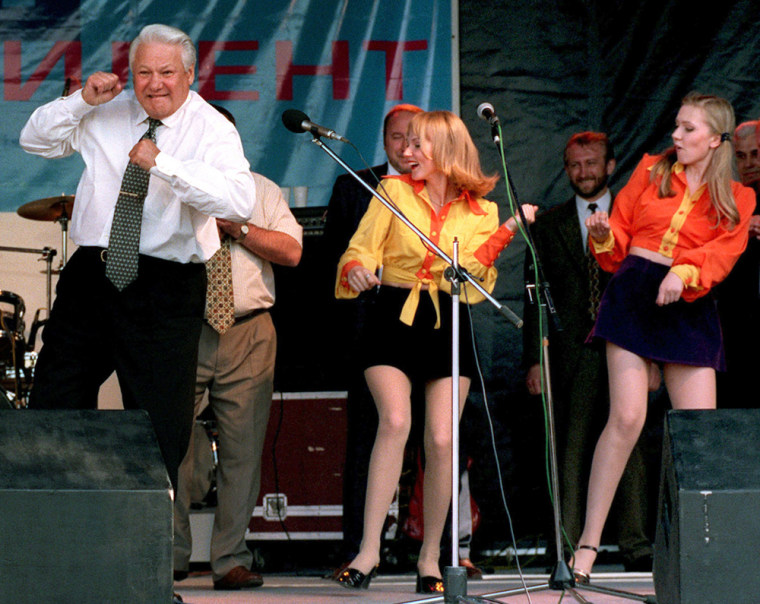
Former Russian President Boris Yeltsin developed a penchant over 15 years in high office of jolting world leaders by committing gaffes, cracking off-color jokes or blurting out flippant comments.
Never comfortable with the rigid protocol required for high-level meetings, Yeltsin frequently shunned the niceties of diplomacy to say — or do — exactly what came to mind.
Sometimes Yeltsin's lapses appeared related to excessive drinking, though aides always vehemently denied it.
His outlandish behavior grabbed headlines even in Soviet times — before his victory as Russia's first democratically elected president in 1991.
In 1989, Yeltsin had to account to the Supreme Soviet for how he had ended up at a police post outside Moscow dripping wet and wearing only his underwear.
He said he had been attacked, his head covered with a sack and dumped off a bridge into a river. Top communists said he had been drunk while on his way to a tryst with a lover.
Worldwide audience Once in office, with the Soviet Union replaced by 15 states, Yeltsin's antics attracted worldwide television attention.
In 1992, he played the spoons, a popular musical instrument in Russia, on the head of Askar Akayev, the president of ex-Soviet Kyrgyzstan.
In 1994, Yeltsin shocked officials during a picnic on a boat steaming down the Volga by suddenly ordering his border guards to toss his spokesman Vyacheslav Kostikov into the cold river.
Officials marking the departure of the last Russian troops from Germany the same year looked on aghast as he stumbled after a champagne lunch, seized the baton from the leader of a military band and insisted on doing the conducting himself.
Later the same day, he grabbed a microphone at a reception and sang tunelessly.
In perhaps the most celebrated incident, Yeltsin failed to emerge from his plane for talks with Ireland's prime minister during a stopover at Shannon airport in 1994, leaving his hosts stunned on the tarmac. An aide said he was exhausted, not drunk, after a U.S. visit.
Secretary gets a backrub Never one to respect political or gender correctness, television cameras caught him at a 1995 meeting with foreign correspondents playfully tweaking the backside of a secretary.
Cameras also showed him energetically twisting on stage to rock music during his 1996 re-election bid. Later, it emerged that he had suffered a heart attack several days earlier.
Fatigue was cited when Yeltsin startled listeners in Sweden in 1997 with a dramatic pledge to cut Russia's nuclear arsenal and seek a total world ban on nuclear weapons.
A Kremlin spokesman said Yeltsin had made the comment after a long day of meetings.
Sometimes, he would resort to homespun anecdotes — and Russians' fondness for vodka — to appeal to ordinary Russians.
"Some say that vodka is too cheap now and we should raise prices. But I haven't the courage to do so yet," he said in the run-up to the 1996 campaign.
"People have special feelings toward this drink. They don't mind a nip or two after work. So I won't be in a hurry to raise prices."
20 years since Boris Yeltsin kept the Taoiseach waiting
Richard Fitzpatrick looks back at the day the Russian premier couldn’t be roused from his plane to meet the Taoiseach
Derry Molony, 61, was working as an airline rep at Shannon Airport that morning. “The first I noticed about it was that I saw the army band practicing on the ramp. I went into Aer Lingus Operations where my late brother, Liam, was working in Control. I said, ‘What is the band doing out there?’ He said, ‘Boris Yeltsin is arriving shortly.’
“Then Albert Reynolds appeared. The aircraft appeared. It pulled in just at the corner of the pier building, and there were steps up to it. There was a lovely red carpet at the end of the steps, and the army band playing away, waiting for the door to open. Albert Reynolds was there, standing, looking up at the aircraft. This went on and on and on.
“About 10 of us were inside in Aer Lingus Operations looking out, and the comments were being passed. We were all wondering: will the door open, won’t the door open? What’s going to happen?”
Out on the tarmac, Reynolds stood, with his hands cupped out front, beside a few of his ministers and TDs, including Bertie Ahern, Willie O’Dea and Brian Cowen, who jigged on the spot. The plane had circled overhead for about an hour before landing.
Reynolds recalled in his memoirs: “I was waiting along with the rest of the reception party when the message came through that our very important visitor, the Russian President, Boris Yeltsin, was ‘indisposed’ and there would be a delay in his arrival.
The delaying tactics had no effect. Yeltsin failed to appear. An air hostess carried a bouquet of flowers from Mrs Kathleen Reynolds on board the plane for Mrs Yeltsin.
Eventually, Russia’s Deputy Prime Minister, Oleg Soskovets, emerged from the plane and spoke with Reynolds for half an hour. He explained that Yeltsin was asleep, and that the Russian president would be unable to attend a scheduled news conference about the Northern Ireland peace process. He invited Reynolds to visit Russia. A planned reception at Dromoland Castle nearby was cancelled.
The plane went on its way to Russia. Reynolds denied he’d been snubbed. He told the assembled media on the runway that he understood the Russian president’s predicament. “I completely understand – Mr Yeltsin was acting on the orders of doctors who said it would be better for him not to get off the plane. He’s very ill after the long travelling, as his blood pressure is going up and down. It’s understandable that they didn’t want to take him off the flight.”
When Yeltsin’s plane landed in Moscow, he denied that illness prevented him from alighting from the aircraft in Shannon. “I feel excellent – I can tell you honestly,” he said. “I just overslept. My security guards should have woken me up at Shannon.”
There is a postscript to the story. In August 2006, a year before Yeltsin died, he finally visited Co Clare. He was taken for a day’s deep-sea fishing as part of a three-day trip. Willie O’Callaghan took Yeltsin and an entourage of about 20 out around Hag’s Head on his cruiser, True Light, departing from Liscannor pier, and stopping off on Inis Oírr Island for lunch.
“The man was very frail,” says O’Callaghan. “I’d say he was on his last legs. He had two big male nurses linking him onto the boat. I’d say they were about seven foot and 20 stoners. He was a huge man himself but he was dwarfed alongside them. I was sworn to secrecy and away we went.
“We went up along the Cliffs of Moher. He wanted to catch a shark. He made several attempts to go fishing. He’d sit out in the back of the boat and the guys would actually have to hold the rod for him. He’d just twist the handle. The poor aul divil was that frail.
“There was no sign of a shark. We were catching big pollock, cod and ling. ‘Bait, bait, bait,’ he kept saying. They were only scraps. At one stage, he looked at me and threatened me. The translators told me, ‘He’s after telling you that if you don’t get him a shark that he’s going to send you to the salt mines in Siberia for the rest of your life.’”
Richard Fitzpatrick looks back at the day the Russian president couldn’t be roused from his plane to meet the Taoiseach
more courts articles

More in this section

Watch: Meryl Streep, Jane Fonda walk Cannes red carpet as film festival opens
Lifestyle newsletter.
The best food, health, entertainment and lifestyle content from the irishexaminer.com, direct to your inbox every Friday.
Please click here for our privacy statement.

Our team of experts are on hand to offer advice and answer your questions here

Your digital cookbook

Discover the great outdoors on Ireland's best walking trails Start Exploring
FOLLOW IRISH EXAMINER
The best food, health, entertainment and lifestyle content from the Irish Examiner, direct to your inbox.

Family Notices
© Examiner Echo Group Limited
International tributes abound for 'historic figure' Yeltsin, dead at 76
Social sharing.
Former Russian president Boris Yeltsin, who guided his nation toward democracy and a market economy, died Monday.
Yeltsin, who served as president from 1991 to 1999, was 76.

Yeltsin had several heart attacks during the 1990s, undergoing quintuple bypass surgery in November 1996. He also reportedly suffered from pneumonia, bronchitis and ulcers.
In a 2004 interview, he admitted to having five heart attacks while president, often leaving office without explanation for periods of time.
The Kremlin said the funeral will be Wednesday, a day of national mourning, and that Yeltsin will be buried at Moscow's Novodevichy Cemetery, where many of Russia's most prominent figures are interred.
Yeltsin was the first popularly elected president of the Russian Federation, taking office in June 1991 on a wave of high expectations.
Heguaranteed the rights to free speech, private property and multi-party elections, and opened the borders to trade and travel.
Putin, Gorbachev offer sympathy
Hispopularity sharply declined as he implemented radical economic reforms, a policy that became known as "shock therapy."
Yeltsin created a private sector and opened up the country to private investment, but failed to prevent the looting of state industry as it moved into private hands.
The economic reforms devastated the living standards of much of Russia's population as capita income fell about 75 per cent during Yeltsin's rule.
He resigned during a dramatic New Year's Eve address on Dec. 31, 1999.
Russian President Vladimir Putin, the former KGB agent whom Yeltsin handpicked as his successor in the president's office,said he spoke to Yeltsin's family and offered his "deepest condolences."
Former Soviet president Mikhail Gorbachev, the Soviet Union's final leader, noted Yeltsin's achievements and shortcomings.
"I express the very deepest condolences to the family of the deceased, on whose shoulders rest major events for the good of the country and serious mistakes. A tragic fate," Gorbachev said in a statement.
U.S. President George W. Bush called Yeltsin a "historic figure who served his country during a time of momentous change," while British Prime Minister Tony Blair remembered him as a "remarkable man who saw the need for democratic and economic reform."
Resisted coup
One ofYeltsin's most memorable moments cameon Aug. 19,1991, whenhe opposed an attempted coup by hardlinerswho wanted to oust Gorbachev and end his "perestroika" economicreforms.
Yeltsin stood on top of a tank outside the Russian parliament, a day after Gorbachev was arrested at his vacation homein the Crimea.Saying the attempted coup was unconstitutional, he called for a general strike and peaceful protests. The coup attempt endedunsuccessfully.
Months later,Yeltsinspearheaded the peaceful end of the SovietUnion on Dec. 25.

Yeltsinsent tanks and troops in October 1993 to flush armed, hardline opposition-party supporters out of a hostile Russian parliament after they had sparked violence in the streets of Moscow. And in December 1994, Yeltsin launched a war against separatists in the southern republic of Chechnya.
Tens of thousands of people were killed in the Chechnya conflict and a defeated and humiliated Russian army withdrew at the end of 1996. The war solved nothing and Russian troops resumed fighting in the breakaway region in fall 1999.
In 2000, Yeltsin told Russian television he saw no other option at the time and took full responsibility for the lives lost in Chechnya.
A posting on a Chechen rebel website on Monday reminded readers that Yeltsin was a "war criminal… wanted for crimes against humanity," Reuters said.
Strange behaviour
Yeltsin's behaviour became increasingly bizarre during his years in office as rumours of excessive drinking swirled.

Later the same year, he failed to get off a plane during an official visit to Ireland. Russian officials told Irish officials that Yeltsin was unwell, while the common belief among journalists covering the visit was that he was drunk.
In 1997, he unexpectedly announced during a visit to Sweden that he would cut Russia's nuclear arsenal by one-third and work toward a total world ban on nuclear weapons. Russian officials scrambled to correct the president.
The following year, during a banquetwith Pope John Paul II, Yeltsin toasted his "love of Italian women," and on another occasion, played wooden spoons on the balding head of Askar Akayev, the president of ex-Soviet stateKyrgyzstan.
He made headlines in Canada for taking former Canadian prime minister Brian Mulroney boar hunting in 1993, a move that angered animal activists.
Yeltsin was born to a poor peasant family in the Ural mountains and studied engineering and worked as a construction manager before joining the Communist party.
With files from the Associated Press
Related Stories
- FROM CBC ARCHIVES: Remembering Boris Yeltsin
- PHOTO GALLERY: Boris Yeltsin
- IN DEPTH: Russia
- YOUR VIEW: What do you think Yeltsin's legacy will be?

The Best Time to Visit Ireland (Pros + Cons of Each Month)
By Author Keith O'Hara
Posted on Last updated: April 26, 2024

There is no single best time of year to visit Ireland, and I’m saying that having lived here for 35 years.
‘Best’ is dependant on you . For example , if you want to visit when the weather in Ireland is likely to be good. ‘Best’ will be summer.
Below, you’ll find the pros and cons for each month to help you decide the best time to visit Ireland based on your likes and dislikes .
But first, a quick overview:
- Summer (Jun, Jul + Aug): Warmest months. Crowd/flight prices are at peak
- Winter (Dec, Jan + Feb): Coldest months. Crowd/flight prices are lower
- Autumn (Sept, Oct + Nov): Days long in Sept + Oct. Short + wintery in Nov
- Spring (Mar, Apr + May): Tends to be rainy in Mar + Apr. Summery in May
The best time to visit Ireland
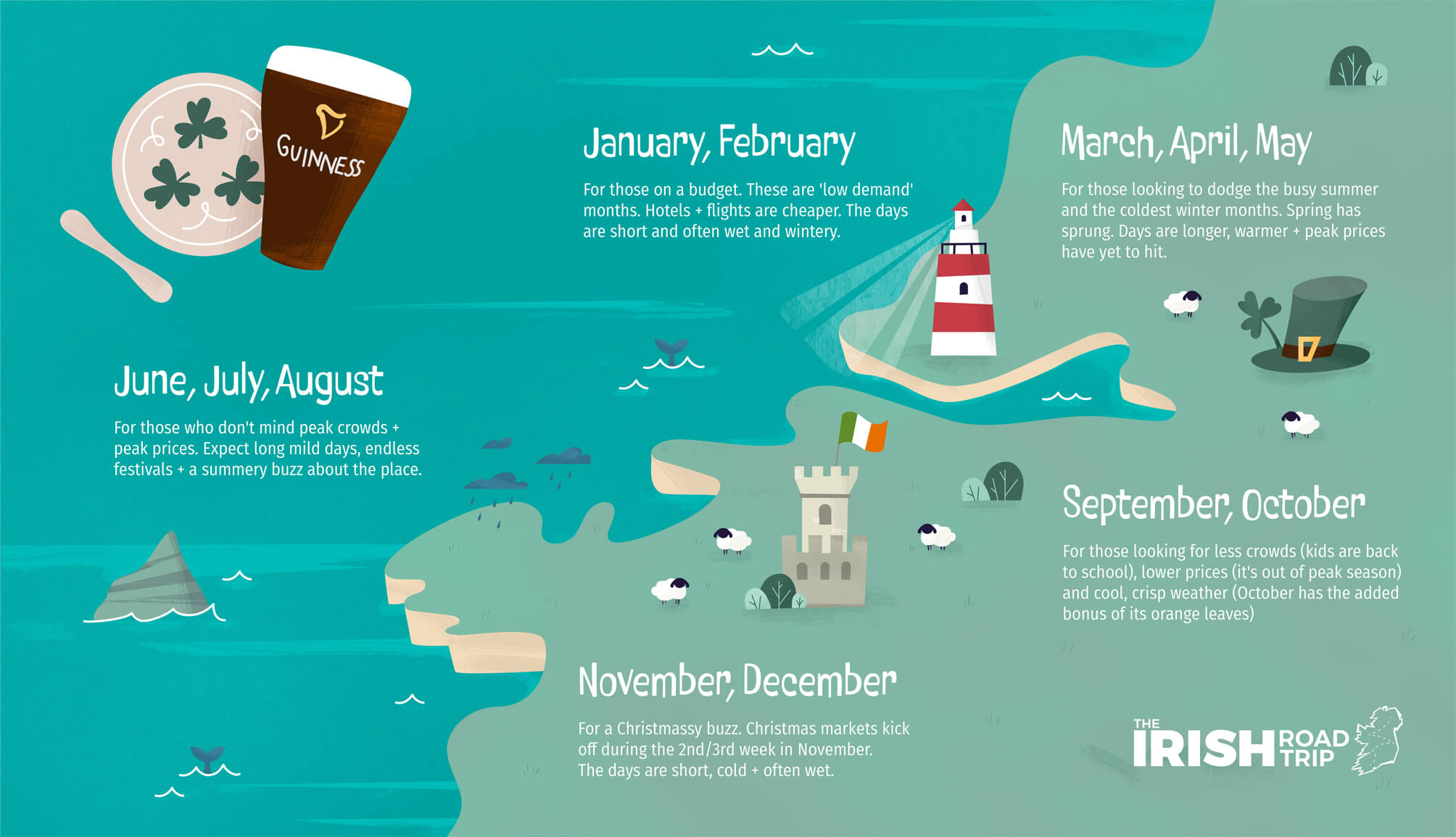
If you take 20 seconds to look at the illustration above, you’ll get a quick insight into the months in Ireland and what to expect from each.
Below, you’ll find an overview of each month with info on average temperatures, festivals, what to wear in Ireland during that month along with travel tips for Ireland .
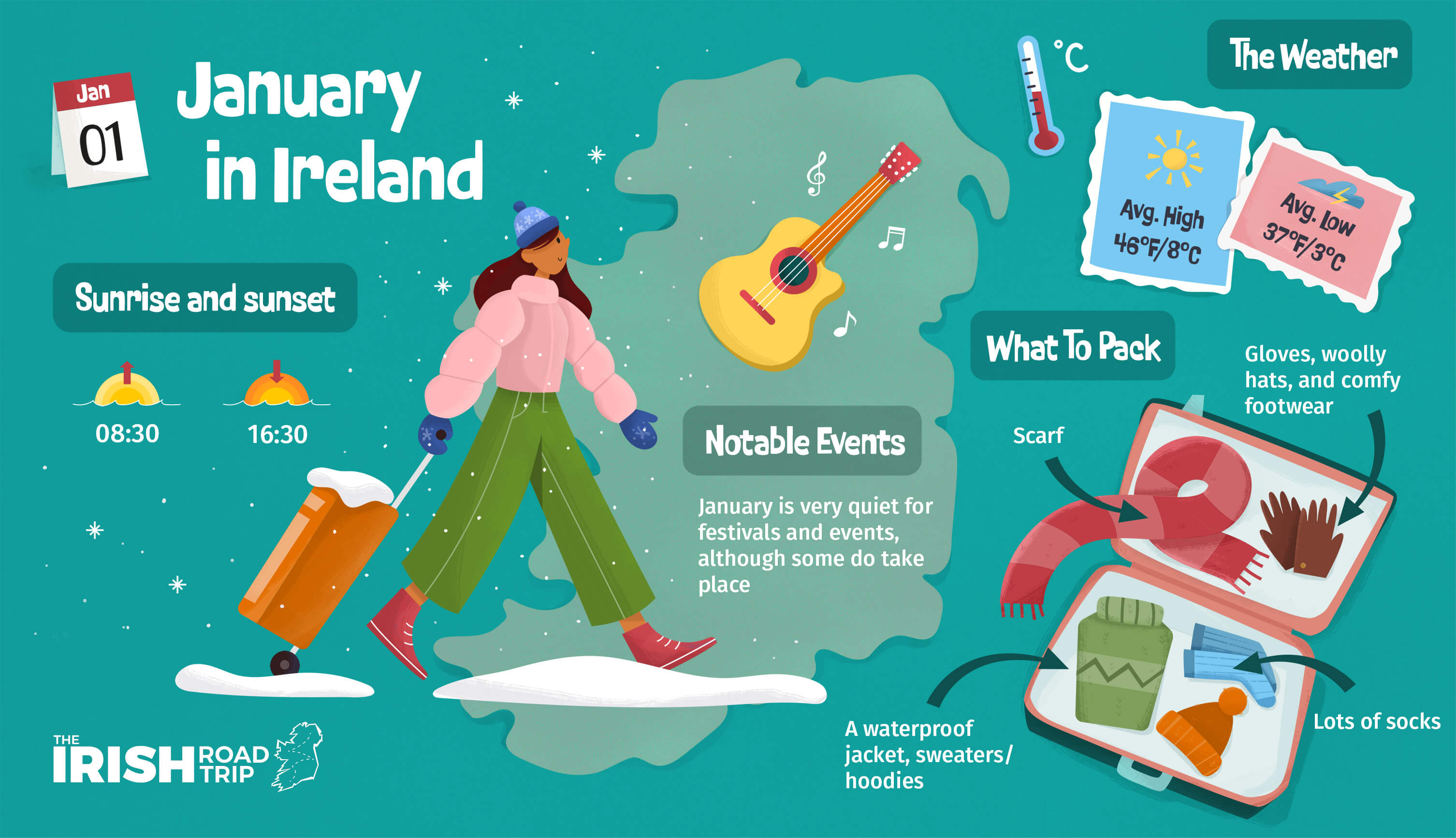
Click to enlarge image
Ireland in January can be very hit and miss. The average temperature in January is 7°C/44.6°F with average lows of 3°C/37.4°F.
January is the best month to visit Ireland if you are working with a tight budget and you are willing to take a gamble with the weather.
- Prices : If you’re visiting Ireland on a budget , flights and accommodation are cheaper
- Crowds : The popular attractions in Ireland will be quieter, as this is off-season
Disadvantages
- The weather : The days tend to be cold, wet, and windy
- Daylight : The sun rises from 08:29 and sets from 16:38
- Closed attractions : Some seasonal attractions will be closed

Visiting Ireland in February can also be risky weather wise, with average highs of 8°C/46.4°F and average lows of 2°C/35.6°F.
Spring is still far from the horizon and the days are short and chilly. In the past, we’ve had heavy snow fall, flooding and stormy weather in February.
February is the best time of year to go to Ireland if you have a limited budget and you aren’t too phased by potentially poor weather conditions.
- Prices : February is off-season in Ireland, so flights and accommodation are cheaper
- Crowds : Ireland’s usually busy attractions will be quieter (the Guinness Storehouse and Giants Causeway will always draw crowds, though)
- Weather : Similar to January – cold, wet and windy
- Daylight : The sun rises at 07:40 and sets at 17:37
- Seasonal attractions : Some seasonal attractions will remain closed

Many people want to visit Ireland in March to attend a St. Patrick’s Day festival or to soak up the buzz surrounding March 17th.
March marks the arrival of spring in Ireland. In years past, we’ve had heatwaves in March and stormy weather.
March is the best time to go to Ireland if you have a sizable budget and want to experience St. Patrick’s Day festivities. Spring has sprung, the days are longer and the weather isn’t as cold as the previous months.
- Weather : March marks the start of spring. There are average highs of 10°C/50°F and average lows of 4°C/39.2°F
- Long ish days : The sun rises at 07:12 and sets at 18:17
- Prices : The period around March 17th sees prices skyrocket. The end of the month (Easter) can be pricey, also
- Weather : The weather can be very changeable. Over the last five years, we’ve had snow storms, heavy rainfall and scorching weather
- St. Patrick’s Day crowds : Crowds are at their peak (it’s for this reason that, for many, March won’t be the best time to visit Dublin )
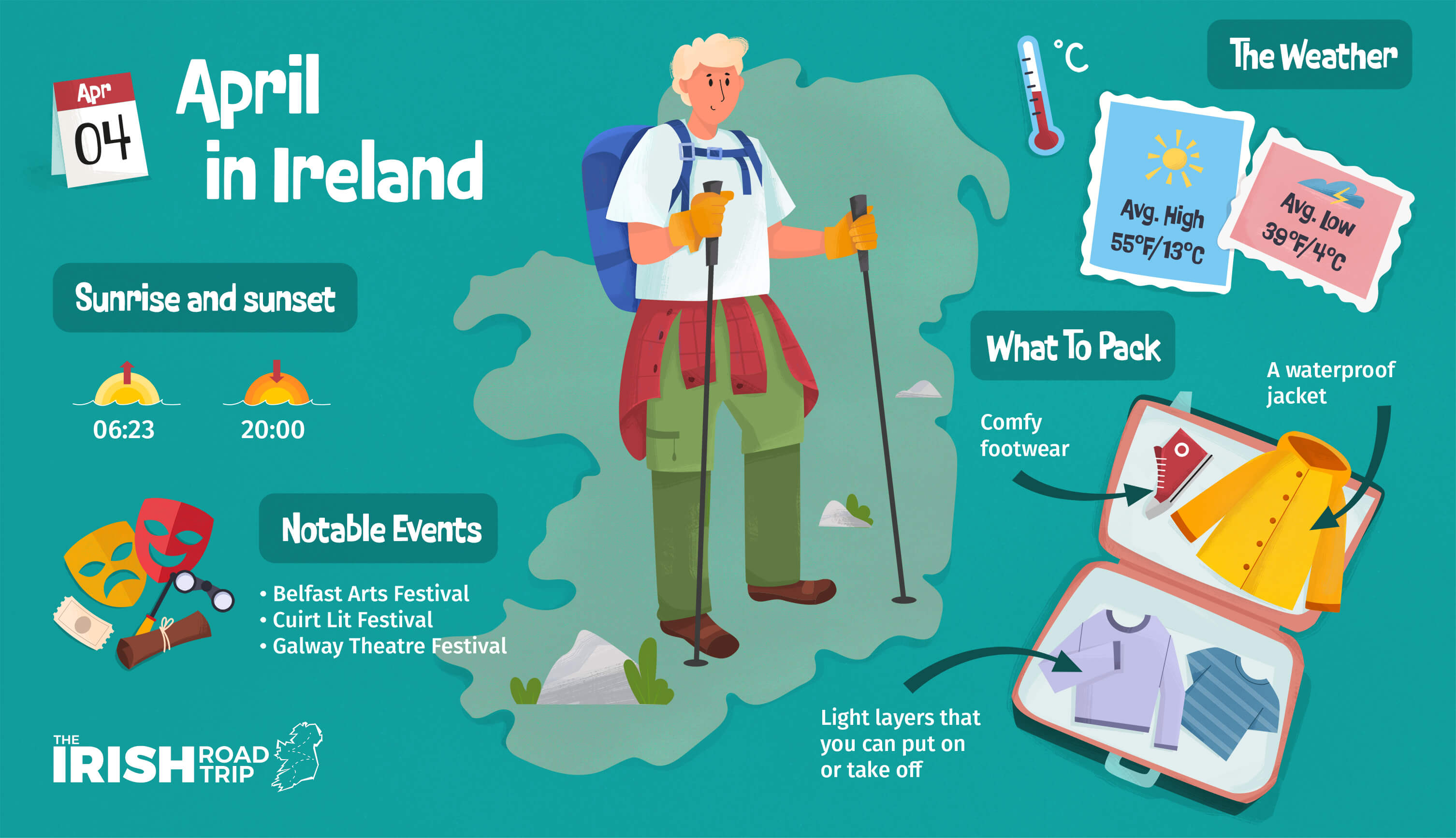
in April, the weather has picked up, the days are longer and there are average highs of 13°C/55°F and average lows of 4°C/39.2°F.
The only issue with April, aside for the potential for bad weather, is that schools get two weeks off, which results in a shortage of accommodation in some places.
April is best time of year to visit Ireland if you’re working within a budget (after Easter) but want plenty of daylight hours to explore the island.
- Flights : The cost of a trip to Ireland is much less in April, thanks to lower flight prices
- Long days : The sun rises at 06:23 and sets at 20:00
- Weather : The weather can to be nice and mild
- Easter holidays : Schools get 2 weeks off around Easter, which can drive up the cost of accommodation
- Weather : The weather can also be terrible (see our April weather guide )
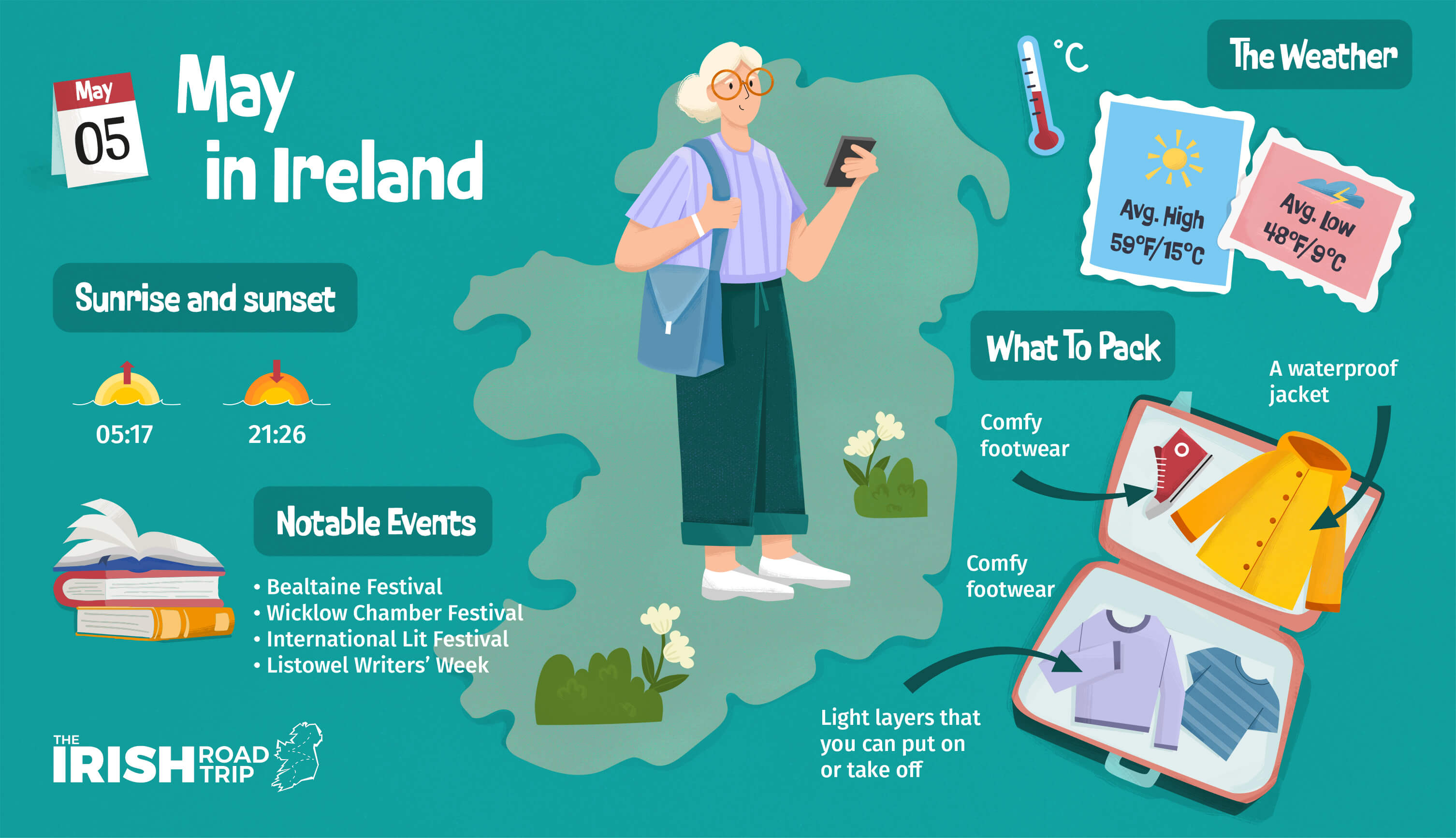
Along with September and October, May is the best time to visit Ireland. This is the shoulder season and the weather is mild, the days are long and both prices and tourist numbers are yet to skyrocket.
I.e. the weather is mild, the days are nice and long and we’ve haven’t yet reached the summer holidays, so places aren’t too busy (see our guide to Ireland in May for more).
- Weather : The weather in May can be good, with mean temperatures ranging between 9.0°C/48.2°F and 13.0°C/55.4°F
- Long days : The sun rises at 05:17 and sets at 21:26
- Summer buzz : Long, mild days and the incoming summer tends to bring a lively atmosphere to many towns and villages
- Festivals : This is when they really start kicking off (see our Irish festivals calendar)
- Weather : Yep – it’s a pro and a con – the weather in May can also be awful (it was last year!)
- Prices : Accommodation and flights will be near peak level price-wise
- Crowds : Better weather and long days means more people tourists
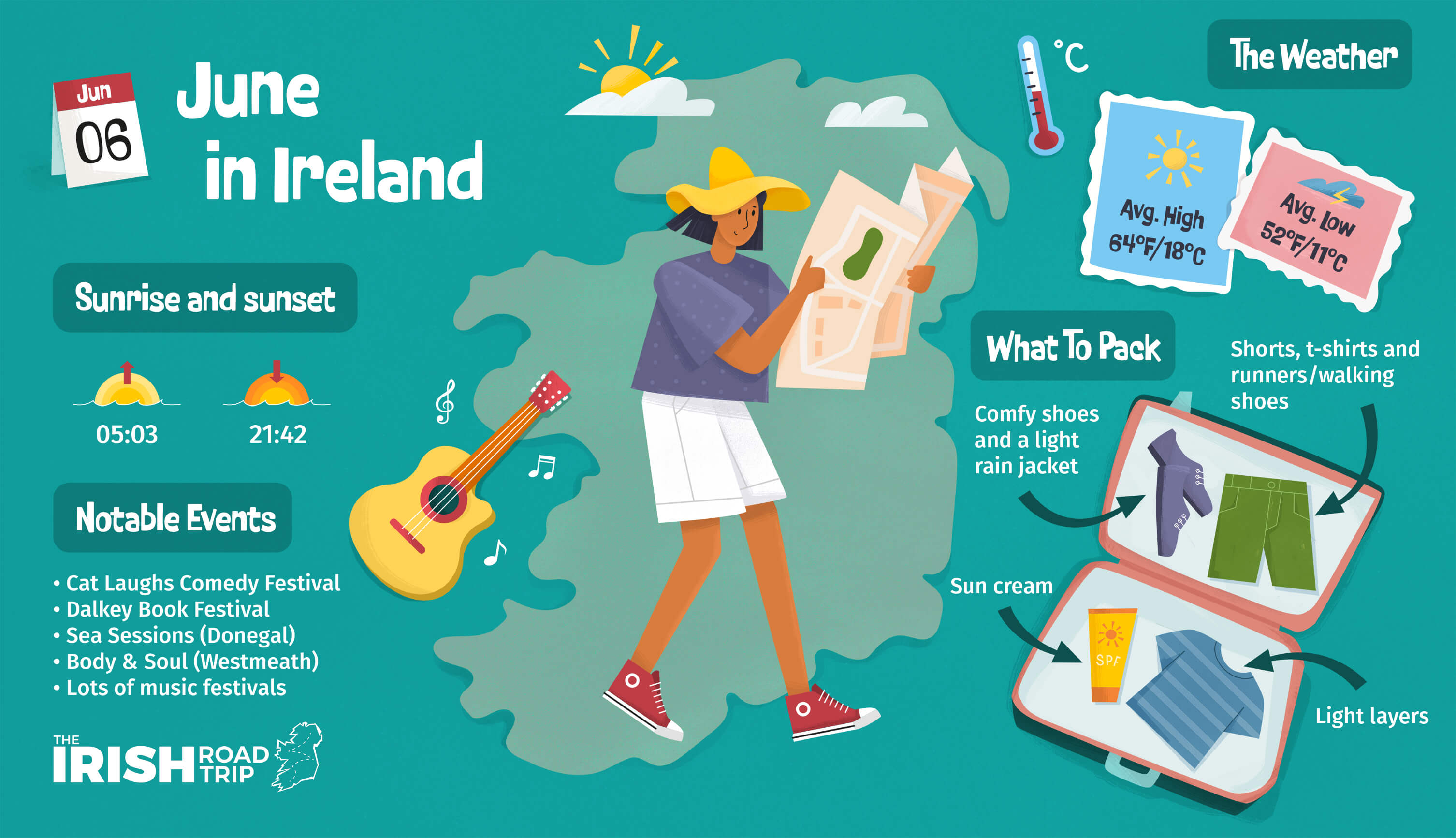
June in Ireland marks the arrival of summer, bringing with it warm and often dry weather and average highs of 18°C/64.4°F and lows of 11.6°C/52.88°F.
This is peak season in every sense – tourist numbers jump as do the price of flights and hotels.
June is regarded as the best time to travel to Ireland by many visiting tourists as the weather tends to be good, temperatures are mild and there’s plenty of daylight hours.
- Weather : Weather tends to be dry and warm with highs of 18°C/64.4°F and lows of 11.6°C/52.88°F
- Long days : The sun rises at 05:03 and sets at 21:42
- Festivals : Numerous music festivals in Ireland take place during June
- Prices : Demand is at its highest, so you can expect to spend more for flights and hotels
- Crowds : As June is peak season in Ireland, expect places to be more crowded
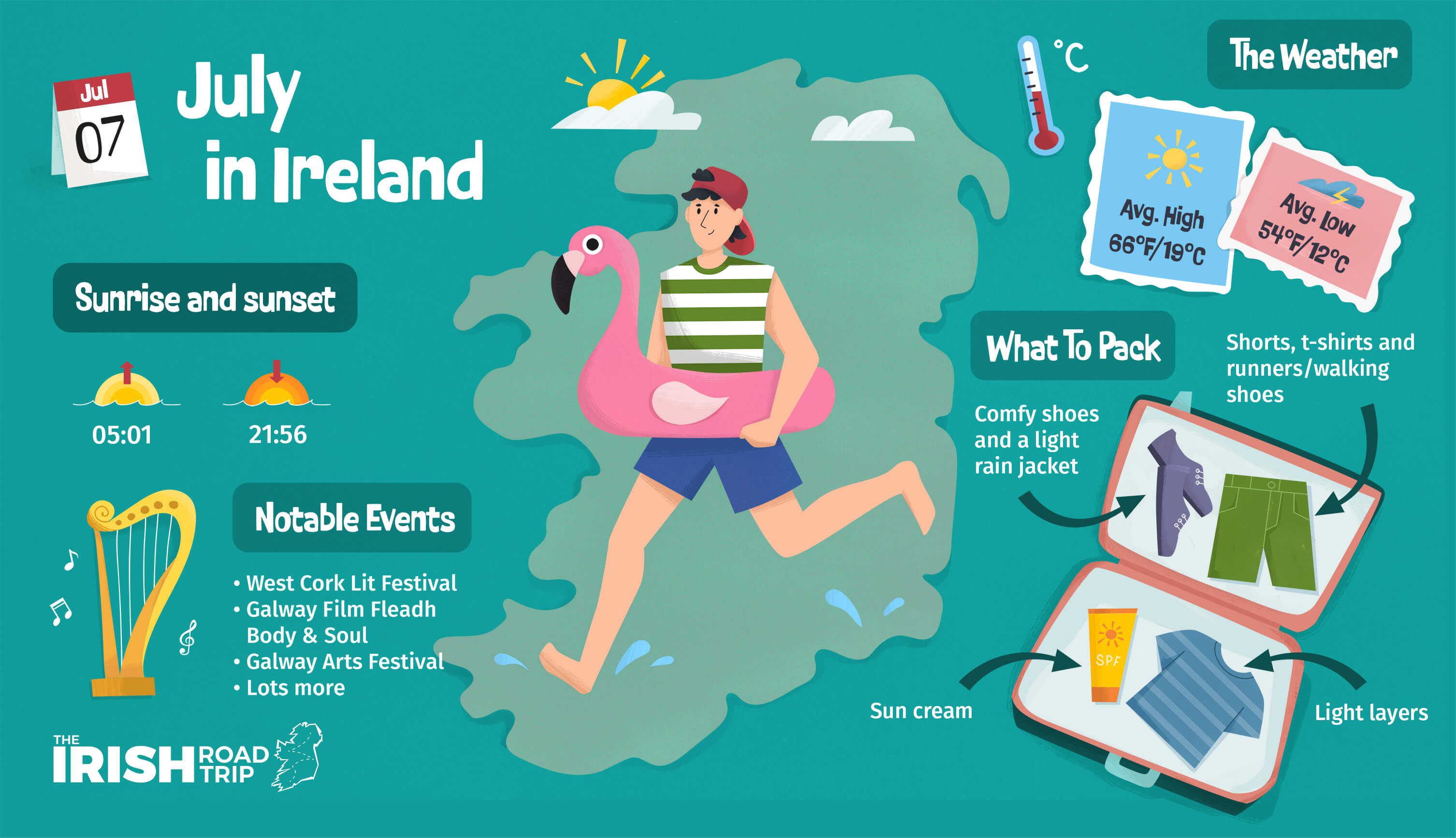
July is the best time to go to Ireland if you’re looking for good weather. Although it’s not guaranteed, it’s more likely to be fine in July than during many other months.
Personally, I head away for one week in Ireland every mid-July and, for the most part, we always get decent weather (see our guide to Ireland in July for more info).
- Weather : We get average highs of 19°C/66.2°F and lows of 12°C/53.6°F
- Long days : The sun rises at 05:01 and sets at 21:56
- Summer buzz : Long, balmy days tend to bring tourists and a lively atmosphere to many towns, villages and cities
- Prices : Summer is peak season, so you’ll be paying more for hotels, B&Bs and Airbnbs
- Crowds : As the schools are out for the summer, expect more crowds travelling around the island, especially to the likes of Killarney and the Dingle Peninsula
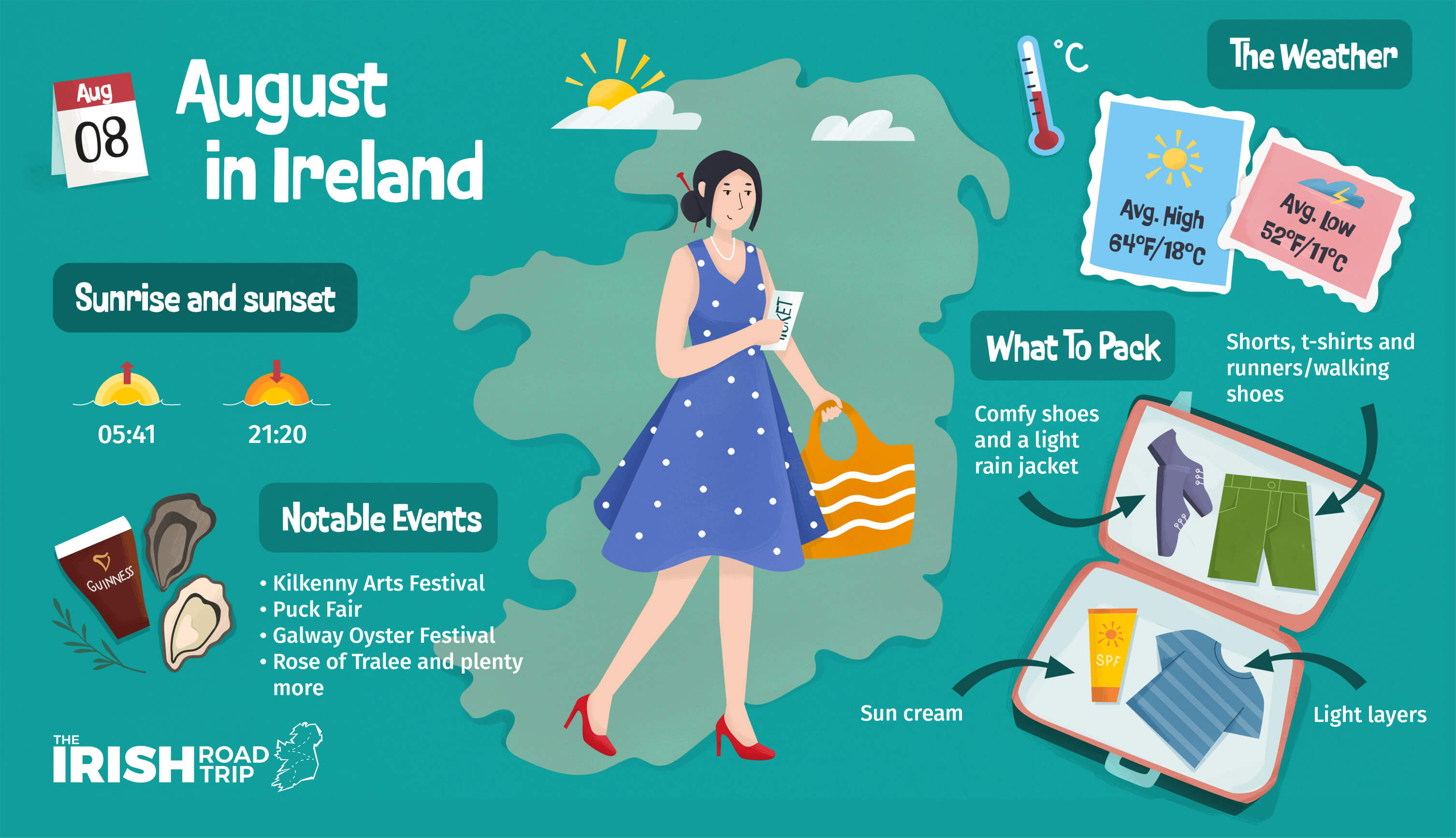
August boasts long days, warm weather and plenty to see and do (see our counties hub for endless places to visit).
As was the case with July, there’s several pros and cons for visiting Ireland in August , many of which revolve around the demand for accommodation and crowds.
August is the best time to go to Ireland if peak prices and crowds don’t bother you. The trade off is mild weather, long days and a busy festival calendar.
- Weather : It’s usually good with highs of 18°C/64.4°F and lows of 11°C/51.8°F
- Long days : You’ll have 16 lovely hours of daylight to wander
- Summer buzz : Again, the summer months bring a buzzy atmosphere to many towns
- Prices : Yep – prices are still at peak levels
- Crowds : The likes of the Dingle Peninsula , the Inishowen Peninsula , the Ring of Kerry and other tourist hot-spots will be very busy
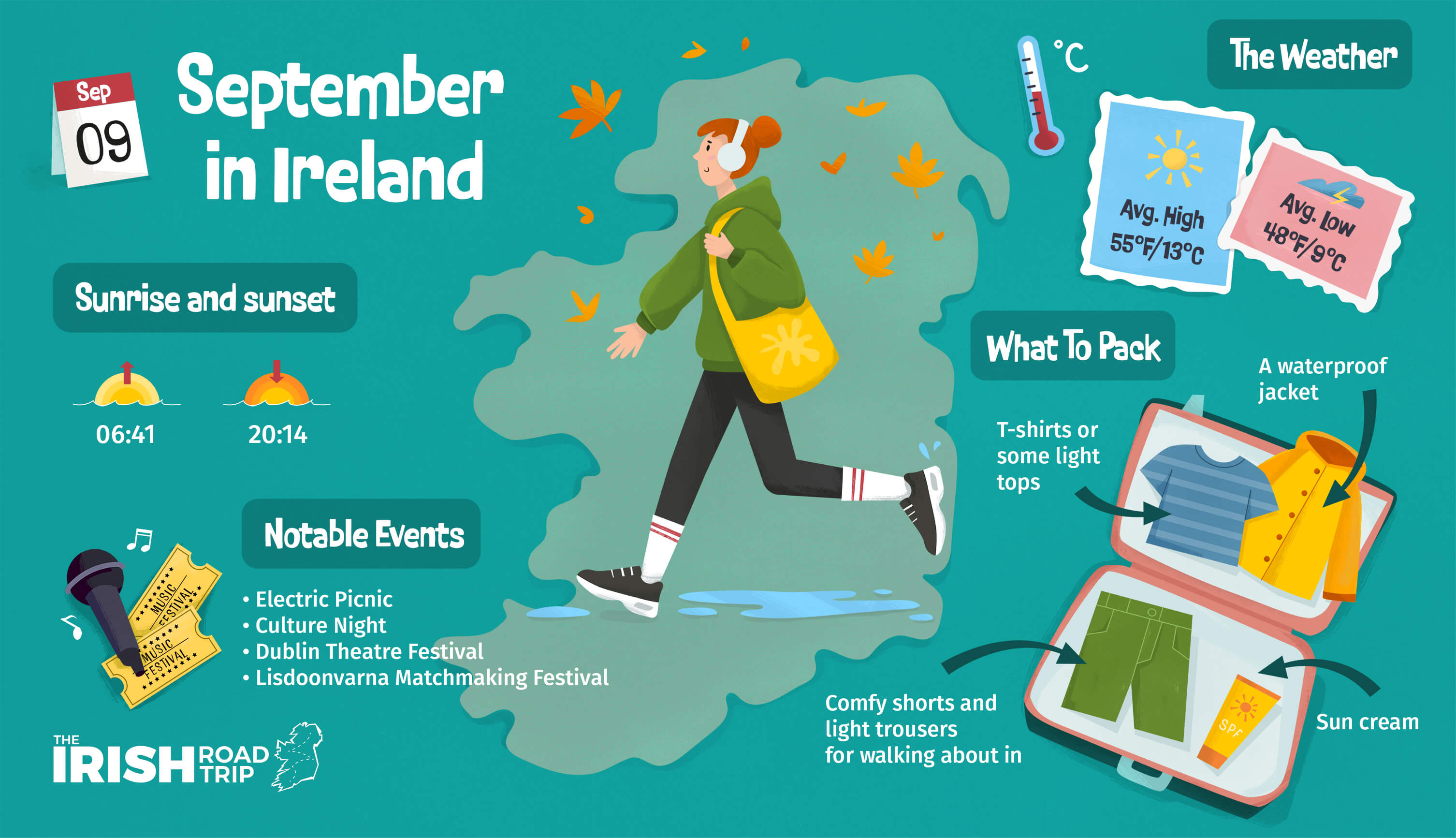
Ireland in September is when the shift from a busy summer season takes place. Tourist numbers drop and the kids go back to school.
This is Ireland’s shoulder season (the season between peak season and the off season) and it’s a great time to explore.
September, along with May and October, is the best time to visit Ireland as prices drop, the days are long, the weather is mild and there’s less crowds.
- Crowds : As kids have gone back to school, there’s less crowds
- The weather : The average high temperature tends to hover between 13°C/55.4°F and 16°C/60.8°F
- Flights : Flights should be a little cheaper as this is the shoulder season
- Long days : The days are starting to shorten, but the sun still rises early at 06:33 and sets at 20:15
- Weather : Yep, a pro and a con. The weather, as always, is unpredictable. With that being said, we’ve had some great Septembers recently
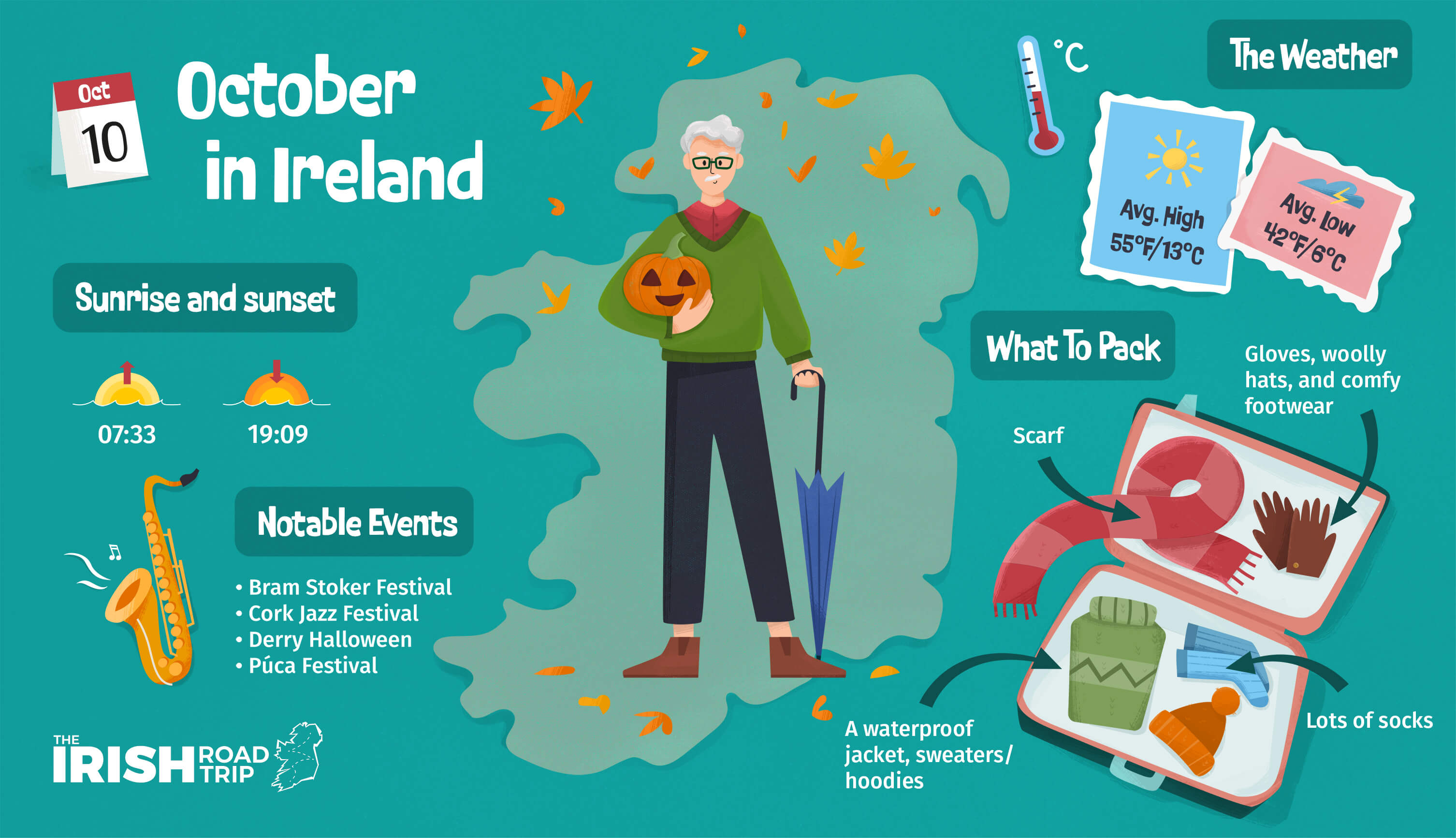
October in Ireland is Autumn and you’ll find many places blanketed in orange leaves and the weather is cool and crisp.
Ireland experiences average highs of 13°C/55°F and average lows of 6°C/42°F during October
October, along with May and September, is the best time to go to Ireland thanks to lower flight and hotel prices, relatively long days and its often dry days with cool temperatures.
- Weather: We often get Octobers that are sunny, crisp and dry
- Crowds: Ireland’s usually busy attractions will be less crowded as we’re no longer in peak-season
- Prices: Accommodation in the more off-the-beaten-track locations will be cheaper (you won’t notice a huge difference in the hot-spots)
- Prices: You should find that flights are cheaper than in peak-season
- Shorter days : By mid-October, the sun won’t rise until 08:00 and it sets at 18:40
- Weather : The weather in Ireland in October is unpredictable (see our October weather guide )
- Mid-term : Schools break in Ireland at Halloween for a week and hotel prices jump

Visiting Ireland in November comes with its pros and cons. On the plus side, many towns and villages come alive with Christmas markets from mid-month.
On the con side, it’s winter , so the weather can be all over the place. November tends to be cool and crisp with an average temperature in Ireland in November between 12°C/53.6°F and 9.5°C/49.1°F.
November is the best time to travel to Ireland for a city break. Many cities (Galway, Dublin, Cork and Belfast) holding Christmas markets.
- Crowds : You’ll encounter fewer crowds at the usually busy attractions (although places with Christmas markets will be busy)
- Prices : Accommodation in the more off-the-beaten-track towns in Ireland will be more affordable
- Flights : Should be cheaper as we’ll be in the depths of the off-season
- Short days : The sun doesn’t rise until 07:23 and it sets early at 16:53
- Seasonal attractions : Some seasonal attractions in Ireland’s quieter villages in towns will be closed
- Weather : The weather could be wintery. We’ve had mild, stormy and freezing cold Novembers in the past few years
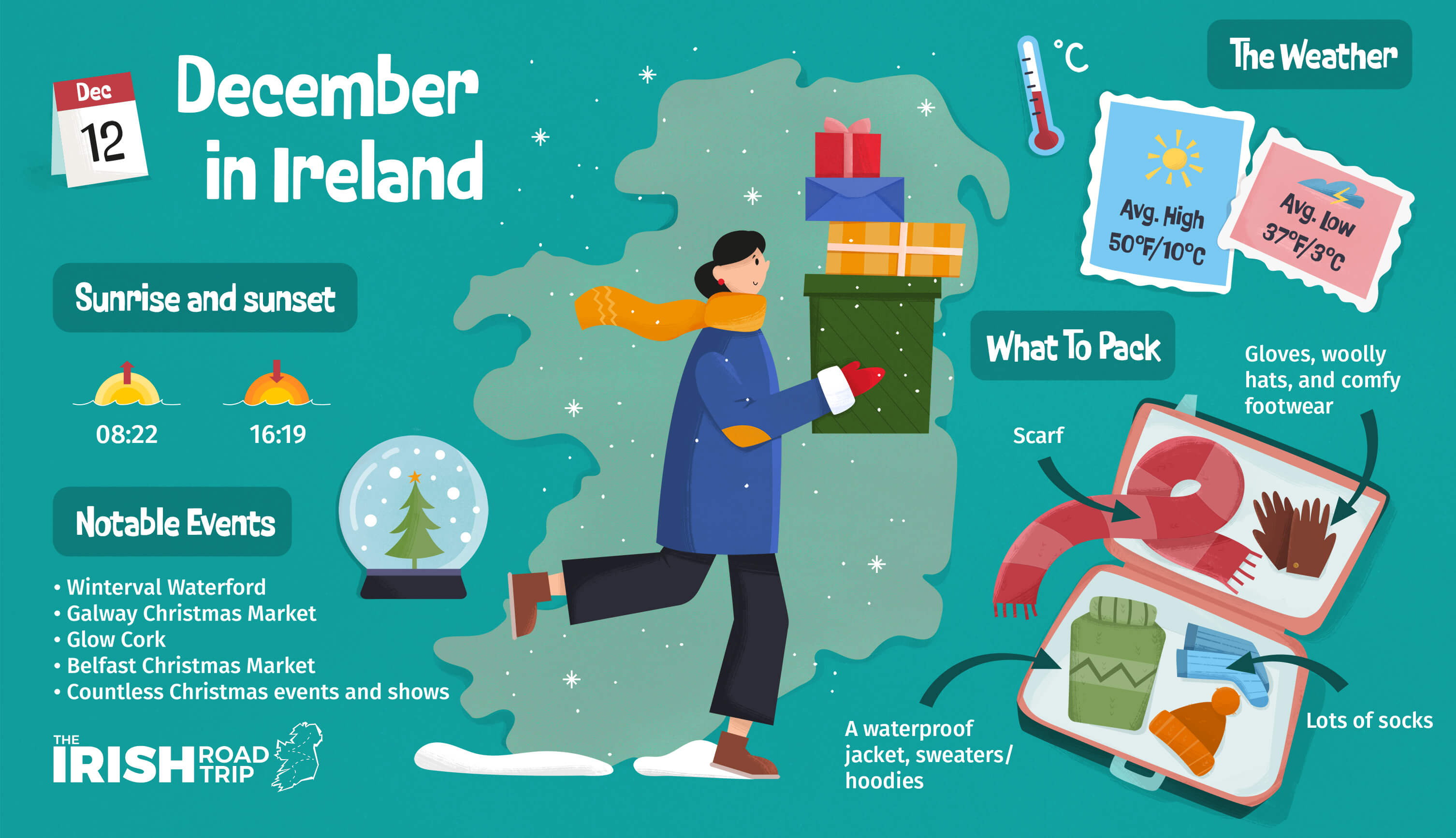
December marks the arrival of Christmas in Ireland and you’ll find most towns and villages alight with fairy lights.
The average temperature for Ireland in December tends to be similar to November, coming in at around 5°C/41°F, but this can vary.
December is the best time to visit Ireland if you’re happy to chance the weather and you want to experience Christmas markets, cosy pubs with big open fires and less crowds.
- Festive buzz : Most towns and villages in Ireland will be decked out in Christmas lights
- Crowds : You’ll encounter fewer crowds at the usually busy attractions
- Prices : Accommodation in the more off-the-beaten-track towns and villages will be cheaper
- Flights : Flights can be pricey with people flying home for Christmas
- Short days : Sun rises at 08:16 and sets around 16:10
- Weather : The weather in December has been mild for several years, but there’s also a good chance of rain and strong winds
The best time to go to Ireland climate wise
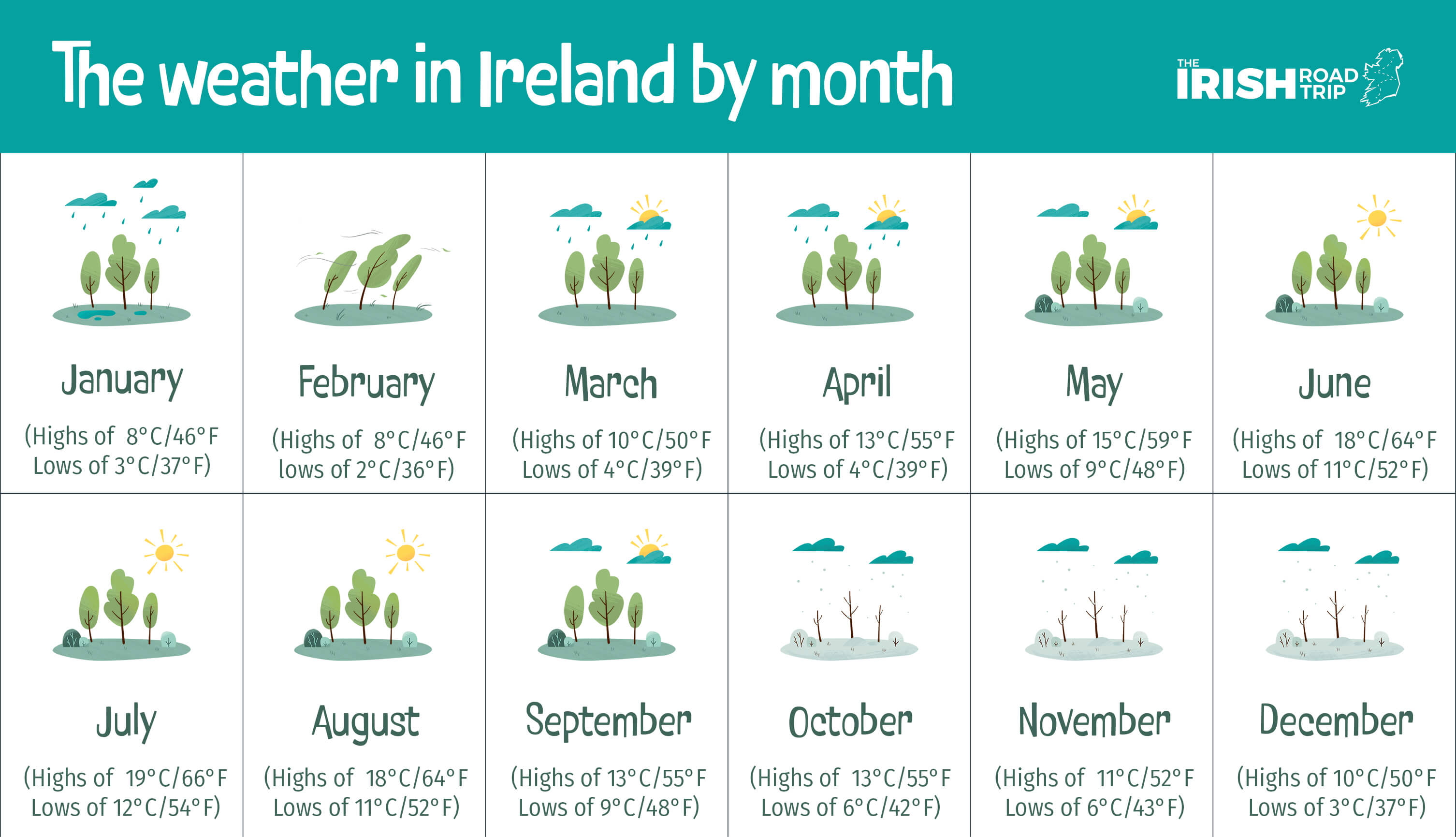
For most, the best months to visit Ireland will be the ones where the weather is at its best. For those planning a trip to Ireland on a budget, it’ll likely be the off-season months.
Below, I’ll give you an overview of the climate in Ireland by month in some of the tourist hot-spots, like Killarney. This data comes from Met Eireann , the Irish Meteorological Service.
Need help with your Ireland itinerary ? We recently published the world’s largest library of Irish Road Trip guides (and it’s free!)
Summer (June, July and August)
Autumn (september, october and november), winter (december, january and february), spring (march, april and may).
Keith O’Hara has lived in Ireland for 35 years and has spent most of the last 10 creating what is now The Irish Road Trip guide. Over the years, the website has published thousands of meticulously researched Ireland travel guides, welcoming 30 million+ visitors along the way. In 2022, the Irish Road Trip team published the world’s largest collection of Irish Road Trip itineraries . Keith lives in Dublin with his dog Toby and finds writing in the 3rd person minus craic altogether.
This site uses Akismet to reduce spam. Learn how your comment data is processed .
Monday 8th of March 2021
Hi! Thank you so much for all of your wonderful tips! My husband and I are planning to bring our adult daughters (24 and 29) to visit at the end is September. We are very excited! Should we stay in Dublin and then take our guided tours from there? We will have 9-10 days. Thank you! Janine
Thursday 27th of February 2020
We just booked a trip to southern Ireland for November. I am very excited. Can you recommend some must do's while we are there?
Wednesday 4th of March 2020
If you hop into our guide to the counties of Ireland you'll find heaps of things to do!
Thursday 30th of January 2020
Hi Keith Thankyou for the great read. My daughter and I are wanting to travel to Ireland for Xmas from Australia. As it will be cold n rainy which doesn’t really bother us, but worried we mighten get to see a lot of attractions would many be closed? Cheers Toni ?
Saturday 1st of February 2020
If you pop in the name of the attraction into Google and visit the official site you should get an idea of whether or not they'll be open or close when you're visiting.
Everywhere will be closed on Christmas Day with many places also staying closed on December 26th, but that can change from attraction to attraction.

Sign Up Today
Start your 14 day free trial today

The History Hit Miscellany of Facts, Figures and Fascinating Finds
- 20th Century
10 Facts About Boris Yeltsin

Owen Howells Ottin
04 mar 2022.

Boris Yeltsin was president of Russia from 1991 to 1999, the first popularly and freely elected leader in Russian history. Ultimately, Yeltsin was a mixed figure on the international stage, variously considered a heroic visionary who helped bring down the USSR peacefully and took Russia into a new era, yet also a chaotic and ineffective alcoholic, more often the focus of ridicule than praise.
Yeltsin left a freer world, playing a pivotal role in the collapse of the Soviet Union , yet underdelivered on many of the promises of economic prosperity he made to the Russian people. His presidency was characterised by Russia’s move to a free-market economy, conflicts in Chechnya and his own recurring health struggles.
Here are 10 facts about Boris Yeltsin.
1. His family were purged
The year before Yeltsin was born in 1931, Yeltsin’s grandfather Ignatii was accused of being a kulak (wealthy peasant) during Stalin’s purges . The family’s lands were confiscated, and Yeltsin’s grandparents were sent to Siberia. Yeltsin’s parents were forced into a kholkoz (collective farm).

2. He lost his finger playing catch with a grenade
Whilst at secondary school, Yeltsin was an active sportsman and prankster. One prank backfired spectacularly, when the grenade he was playing with exploded, taking off the thumb and index finger of his left hand.
3. He admitted to reading illegal literature
Despite being a devout communist to begin with, Yeltsin became disillusioned with the totalitarian and hard-line elements of the regime. This was reinforced, he would later claim, when he read an illegal copy of The Gulag Archipelago by Aleksandr Solzhenitsyn. The book, detailing the worst atrocities of the Gulag system , became a key read in the underground literature or ‘samzidat’ of the USSR.

Chairman of the Presidium of the Supreme Soviet of the Russian SFSR, Boris Yeltsin, in a crowd of press at the Kremlin. 1991.
Image Credit: Konstantin Gushcha / Shutterstock.com

4. He resigned from the Politbureau in 1987
Yeltsin handed in his resignation from the Politbureau (the control centre of the USSR’s Communist Party) in 1987. Before this resignation, Yeltsin had been openly critical of the party’s stunted reforms and, by extension, of the USSR’s leader at the time, Mikhail Gorbachev. This marked the first time in history that someone had voluntarily resigned from the Politbureau.
5. He once gave a speech sitting on the barrel of a tank
On 18 August 1991, just over two months after being elected as president of the Russian Soviet Federative Socialist Republic (SFSR), Yeltsin found himself defending the USSR from a coup by communist hardliners opposed to Gorbachev’s reforms. Yeltsin sat atop one of the coup-plotters’ tanks in Moscow and rallied the crowd. Soon after the coup failed, and Yeltsin emerged a hero.
6. Yeltsin signed the Belovezh Accords in 1991
On 8 December 1991, Yeltsin signed the Belovezh Accords in a ‘dacha’ (holiday cottage) in Belovezhskaya Pushcha in Belarus, effectively ending the USSR. He was accompanied by the leaders of the Belarussian and Ukrainian SSRs. Kazakhstan’s leader attempted to join but his plane was diverted.
Yeltsin had gone into the meeting to discuss the restructuring of the USSR, yet in a matter of hours and many drinks later, the death warrant of the state was signed. The original document was found to have gone missing in 2013.
7. He had major alcohol issues
An intoxicated Yeltsin, on a visit to US President Bill Clinton , was once found running down Pennsylvania Ave, wearing only his pants, trying to hail a taxi and order a pizza. He only returned to his hotel when he was promised a pizza would be delivered.
Yeltsin also once played the spoons on the head of the (bald) President Askar Akayev of Kyrgyzstan.

President Clinton laughing at a joke made by President Yeltsin. 1995.
Image Credit: Ralph Alswang via Wikimedia Commons/Public Domain
8. He embarrassed a party of Irish officials in 1994
On 30 September 1994, Yeltsin left a party of dignitaries, including Irish ministers, waiting awkwardly on the runways of Ireland’s Shannon Airport after allegedly being too drunk or hungover to depart the plane.
Yeltsin’s daughter would later claim her father had suffered a heart attack. ‘Circling over Shannon’ would go on to become a euphemism for being too drunk to function in Ireland. The incident raised questions about Yeltsin’s health and capacity to function.
9. He came very close to nuclear war
In January 1995 a team of scientists launched a rocket to help study the Northern Lights from Svalbard in Norway . The Russian military, still fearful of a US attack, interpreted this as a potential first strike, and Yeltsin was brought the nuclear suitcase. Thankfully, nuclear armageddon was averted when the true purpose of the rocket was established.
10. He became erratic towards the end of his presidency
In the last days of his presidency, facing 2% approval ratings, Yeltsin became increasingly erratic, hiring and firing ministers almost daily. When he finally resigned on 31 December 1999, the relatively unknown figure he’d appointed as his successor was the last man standing in the game of musical chairs. That man was Vladimir Putin .

You May Also Like

Mac and Cheese in 1736? The Stories of Kensington Palace’s Servants

The Peasants’ Revolt: Rise of the Rebels

10 Myths About Winston Churchill

Medusa: What Was a Gorgon?

10 Facts About the Battle of Shrewsbury

5 of Our Top Podcasts About the Norman Conquest of 1066

How Did 3 People Seemingly Escape From Alcatraz?

5 of Our Top Documentaries About the Norman Conquest of 1066

1848: The Year of Revolutions

What Prompted the Boston Tea Party?

15 Quotes by Nelson Mandela

The History of Advent
Beyond the G8, Yeltsin sees his country in the EU
His business done with president clinton for better or for worse, president yeltsin turned towards europe at a weekend meeting….
HIS BUSINESS done with President Clinton for better or for worse, President Yeltsin turned towards Europe at a weekend meeting with Finland's President Martti Ahtisaari and surprised all observers by saying that Russia wants to be a member of the EU.
Looking far less robust and healthy than he did at his joint press conference with President Clinton on Friday, Mr Yeltsin walked very stiffly, spoke slowly and once appeared to lose his train of thought. He and Mr Ahtisaari met the Finnish and Russian press at the 19th century presidential palace in central Helsinki, constructed when the Grand Duchy of Finland was a part of the Russian empire.
Asked how he would react to accession to membership of the European Union by the Baltic States, and particularly by Estonia, Mr Yeltsin said Russia had no objection to EU membership for the Baltic states. Then he astounded his listeners by proposing that Russia should join the European Union. His country was, he said, "working towards final recognition as a fully European state and we are also prepared to join the European Union".
With Russia's democracy and economy still at the "developing" stage it would naturally be quite some time before Russia could be admitted to EU membership but even if Russia did get itself together the prospect of its membership would be a daunting one for the European Union.
The former soviet president, Mr Mikhail Gorbachev, came up with the concept of a "Common European Home" stretching from the Urals to the Atlantic. But Mr Yeltsin's vision is now of a European Union which would stretch from the straits of Japan to the Aran Islands.
Russia has vast natural wealth, a population of 150 million people many of whom are very highly educated. Thus it has the potential within a generation or slightly longer to become a, or perhaps the, European economic superpower.
Russia is also hoping in the nearer future to join the World Trade Organisation, the Paris Club of creditor nations and to become the eighth member of the G-7 group of wealthy industrialised nations. Acceptance by such organisations is considered very important by Mr Yeltsin's administration as a recognition of Russia's prestige.
Finland, which shares a 1,300 km border with Russia, had the right to develop its own relations with NATO, Mr Yeltsin said, noting that in the past that country's policy of military neutrality had created a "very stable and calm balance, facilitating good neighbourly relations with Russia".
Finland is, like almost all European countries other than Ireland and Malta, a member of the NATO sponsored Partnership for Peace organisation. It has not expressed any intention of joining "NATO and appears satisfied with observer status at the Western European Union.
Reuter adds from Bonn: The German Foreign Minister, Mr Klaus Kinkel, welcomed Mr Yeltsin's desire to strengthen ties with the EU. He said that a partnership agreement Russia had with the EU, "which I did a great deal to get off the ground in 1994, "must be implemented now without delay."
Less effusive about Mr Yeltsin's new stated aims, the European Commission said it had taken note of his remarks.
Seamus Martin
Seamus Martin is a former international editor and Moscow correspondent for The Irish Times
IN THIS SECTION
Yeats sisters and irish design celebrated in new trinity college exhibition, your top stories on friday: voting begins in local and european elections; netflix accused of defamation by woman alleged to be ‘martha’ in baby reindeer, boat carrying human rights activists headed for gaza to stop off in cork harbour this weekend, teaching staff at etb vote to strike in september if enforced transfer of member not revoked, church services, claire byrne and mary lou mcdonald come unexpectedly close to a shouting match, molly martens is free to move on now, leaving behind a trail of nightmarish violence, winner of last week’s rté super garden competition dies, plans of holiday makers across europe in disarray after german travel company collapse, voting in the local and european elections: where to vote, who is on the ballot paper, and other tips, latest stories, israeli forces step up bombing of rafah as tanks try to push west, rishi sunak says sorry for leaving d-day events early to record tv interview, trump suggests tariffs against nations including china over illegal immigration, robbie keane steps down as maccabi tel aviv manager.
- Terms & Conditions
- Privacy Policy
- Cookie Information
- Cookie Settings
- Community Standards
- Share full article
Advertisement
Supported by
Boris Yeltsin, flawed hero with a giant legacy, dies at 76
By Marilyn Berger
- April 23, 2007
Boris Yeltsin, the burly provincial politician who became the first freely elected leader of Russia and a towering figure of his time when he presided over the dissolution of the Soviet Union and the demise of the Communist Party, died Monday, the Kremlin said. He was 76.
The cause was heart failure, Interfax reported, citing unidentified medical sources.
In office less than nine years and plagued by severe health problems, Yeltsin added a final chapter to his historical record when, in a stunning coup at the close of the 20th century, he announced his resignation and became the first Russian leader to relinquish power on his own in accordance with constitutional processes. He then turned over the reins of office to his handpicked successor, Vladimir Putin.
Yeltsin left a giant, if flawed, legacy. He started to establish a democratic state and then pulled back, lurching from one prime minister to another in an effort to control the levers of power. But where his predecessor, Mikhail Gorbachev sought to perpetuate the Communist Party, Yeltsin helped break the party's hold over the Russian people.
Although his commitment to reform wavered, Yeltsin eliminated government censorship of the press, tolerated public criticism and steered Russia toward a free market. The rapid privatization of industry led to a form of buccaneer capitalism, and a new class of oligarchs usurped political power as they plundered the country's resources, but Yeltsin's actions assured that there would be no turning back to the centralized Soviet command economy that had strangled growth and reduced a country populated by talented and cultured people and rich in natural resources to a beggar among nations.
Not least, Yeltsin was instrumental in dismembering the Soviet Union and allowing its former republics to make their way as independent states.
The Yeltsin era effectively began in August 1991, when he clambered atop a tank to rally Muscovites to put down a right-wing coup against Gorbachev, a heroic moment etched in the minds of the Russian people and television viewers all over the world; it ended with his electrifying resignation speech on New Year's Eve 1999, surprising the world. He asked forgiveness for his mistakes and turned over the government to Putin, a loyal aide and former officer of the KGB. In return, Yeltsin received a grant of immunity from criminal prosecution and credit for leaving the Kremlin voluntarily.
To turn around the battleship that was the Soviet Union, with its bloated military-industrial establishment, its ravaged economy, its devastated environment and its antiquated and inefficient health and social services system, would have been a Herculean task for any leader in the prime of life and the best of health. But in Russia, the job of building a new state from the ashes of the old was taken on by Yeltsin, the dedicated but imperfect reformer, a man in precarious health whose frequent mysterious disappearances from public life were attributed to heart and respiratory problems, excessive drinking and bouts of depression. These personal weaknesses left a sense of lost opportunity.
Yeltsin left with his fondest wish for the Russian people only partly fulfilled. "I want their lives to improve before my own eyes," he once said, remembering the hardship of growing up in a single room in a cold communal hut, "that is the most important thing."
In fact, in the dislocation and chaos that accompanied the transition from the centralized economy he had inherited from the old Soviet Union, most people saw their circumstances deteriorate. Inflation became rampant, the poor became poorer, profiteers grew rich, the military and many state employees went unpaid and flagrant criminality flourished. Much of Russia's inheritance from the Soviet Union stubbornly endures.
Gorbachev had sought to preserve the Soviet Union and, with his programs of glasnost and perestroika, to give communism a more human dimension. Yeltsin, on the other hand, believed that democracy, the rule of law and the market were the answers to Russia's problems.
During a visit to the United States in 1989 he became more convinced than ever that Russia had been ruinously damaged by the centralized, state-run economic system where people stood in long lines to buy the most basic needs of life and more often than not found the shelves bare. He was overwhelmed by what he saw at a Houston supermarket, by the kaleidoscopic variety of meats and vegetables available to ordinary Americans.
"I think we have committed a crime against our people by making their standard of living so incomparably lower than that of the Americans," Leon Aron quoted Yeltsin as saying in the biography "Yeltsin, a Revolutionary Life."
An aide, Lev Sukhanov was reported to have said that it was at that moment that "the last vestige of Bolshevism collapsed" inside his boss.
Yeltsin was, all in all, a survivor: outlasting expulsion from the Communist Party Politburo in 1987, the Communist coup attempt in 1993, the failed effort to subdue the breakaway republic of Chechnya in 1994, a new challenge from the Communists in 1996, economic collapse in 1998 and a Communist-led drive to impeach him in 1999.
He also survived frequent bouts of influenza, bronchitis and pneumonia, quintuple bypass surgery in 1996 with continuing heart problems, a bleeding ulcer, a bizarre near drowning before he ever achieved high office, uncounted missed appointments and even the spectacle of toppling over at official ceremonies.
Nevertheless, he brought about fundamental economic change: a market economy, however distorted and corrupt, an emerging younger class of business executives, and in the last years of his presidency, a gradual reduction in crime.
Politically, too, his reforms had impact. Parliament began to shape politics, the news media kept their newly acquired freedoms, and political rivals competed openly in elections. In his lifetime, the worst that many in Russia and the West had feared never materialized: a Communist revival or new fascism built on chaos.
He failed when it came to the undramatic work of hammering out the political and economic framework needed to consolidate the new Russian state. His refusal to establish a new political party left him without a structure for his reforms. Once he spoke of the possibility of creating a "two-party system" for Russia, but like many of his proposals, this one was half-formed.
"Yeltsin's understanding is a tabula rasa," said Vitaly Tretyakov, who founded Nezavisimaya Gazeta, one of Moscow's most respected newspapers, in 1990. "In economics, his knowledge is nil - nil! In how to construct a state, zero. It's really the same in all fields. It's not his fault, of course. To come to power, he had to contest everything. But leading is a different matter."
Yeltsin's evolution as a politician was ultimately stymied by the fierce opposition that arose to the changes he brought and by the unpopular war he began in Chechnya, which he was unable to win and was unwilling to end. His campaign to subdue the secessionists, starting in December 1994, left as many as 80,000 people dead, undermined his moral authority and threatened his hold on power.
The action exposed the breakdown of the military machine of Russia and raised concern about its stability even as it remained in possession of a huge nuclear arsenal. The killing of civilians and widespread human rights abuses tainted the image of a democratic Russia in the West.
Boris Nikolayevich Yeltsin was born on Feb. 1, 1931, to a peasant family in Butko, a village in the Sverdlovsk district of the Urals.
When his father moved to Berezniki as a laborer, during what Yeltsin remembered as "Stalin's so-called period of industrialization," the family was allocated a single room in a communal hut. He recalled in the first volume of his autobiography, "Against the Grain," that they lived in that hut for 10 years.
"Winter was worst of all," he wrote. "There was nowhere to hide from the cold. Since we had no warm clothes, we would huddle up to the nanny goat to keep warm. We children survived on her milk. She was also our salvation throughout the war."
Even as a boy, Yeltsin challenged authority, and tales of his early brashness were woven into the carefully burnished folklore surrounding him.
Acknowledging that he was something of a "hooligan," he recalled standing up at his graduation from elementary school to denounce a teacher who, he declared, "had no right to teach children because she crippled them mentally and psychologically." He then fought the bureaucrats to get the diploma that was withheld from him as punishment.
At the Urals Polytechnic Institute he studied civil engineering and played volleyball. Playing despite a cold during one long tournament, he said, he first strained his heart. He refused to go to a hospital and went home instead, and forever after remembered his heart pounding violently in his chest.
He did not join the Communist Party until 1961, when he was 30 years old, an age at which Gorbachev was already well on his way up in the hierarchy. For Yeltsin, membership was a move to further his career in the Sverdlovsk construction agency, not an expression of his fervent belief in communism.
Fifteen years later, after serving as a secretary of the Sverdlovsk provincial committee, Yeltsin became party chief for the region and stood out in the stagnation of the Leonid Brezhnev era as an activist less interested in the perquisites of office than in rooting out bureaucratic corruption and improving the lot of the people.
When Gorbachev became general secretary of the party in 1985, he sought out regional leaders, among them Yeltsin. But he may have gotten more than he bargained for in this populist from the east. Seeking a clean image, Yeltsin wrote in his autobiography, he turned down an offer of a government dacha that had previously been assigned to Gorbachev.
"We were shattered by the senselessness of it all," he wrote, after he and his family were taken to see a "cottage" of enormous fireplaces, marble paneling, parquet floors, sumptuous carpets, chandeliers, crystal and luxurious furniture. Enumerating the reception rooms and bedrooms and playrooms and television sets, the man who grew up in a wooden hut with an outhouse wrote: "I lost count of the number of bathrooms and lavatories."
To this he contrasted the simple tastes of his own wife, Naina, and his daughters, Lena and Tanya, who, along with several grandchildren, survive him. Yeltsin once said, "As long as no one can build his own dacha, as long as we continue to live in such relative poverty, I refuse to eat caviar followed by sturgeon."
It was Yeltsin's personal excesses that made him particularly vulnerable. In his 1989 visit to the United States he acted like a vigorous American politician in the middle of a campaign. But reporters also noted the mercurial leader's great thirst for bourbon. In his autobiography, Yeltsin attributed his slurred speech during that visit to the effects of a sleeping pill and exhaustion from jet lag, and he insisted that a videotape was doctored to make him look drunk.
"A man must live like a great bright flame and burn as brightly as he can," Yeltsin said in March 1990. "In the end he burns out. But this is better than a mean little flame."
In the spring of 1990, Yeltsin was elected in a landslide to the Russian state legislature, which voted him president of the Russian Soviet Federated Socialist Republic. This, however, was not enough for Yeltsin; he wanted a popular mandate and called for elections. He stunned his fellow delegates when he resigned from the Communist Party and still won the popular vote for the presidency on June 12, 1991, getting more than 50 percent of the vote in the first round.
It was two months later, in August 1991, that Yeltsin strode from his office in the Russian Republic's headquarters to thwart a right-wing coup. From atop a T-72 tank, Yeltsin declared: "The legally elected president of the country has been removed from power. We proclaim all decisions and decrees of this committee to be illegal."
His ability to rally Muscovites that night suggested that a democratic spirit was taking hold in a land that had known nothing but czars and commissars. His ability to attract support from segments of the Soviet armed forces demonstrated the breakdown of centralized control. Five days later, Gorbachev effectively closed the Bolshevik era when he resigned as general secretary of the Communist Party and dissolved its Central Committee.
But even as Yeltsin took for Russia the mantle of Soviet power, he entered uncharted territory, and his country was already in shambles. "This is a bear, a giant bear," he said. "And this wheel needs to be put in motion. And this is what I want to do, to set it in motion."
Under enormous pressures of economic disintegration and political disarray, Yeltsin set about almost immediately to negotiate the dismantling of the Soviet Union and its constituent republics. Yeltsin first let the Baltic nations of Lithuania, Latvia and Estonia go their own way, ending Gorbachev's increasingly violent efforts to keep them tied to Soviet empire.
By the end of that year, with the leaders of Belarus and Ukraine, he broke the Soviet Union apart and negotiated what became the Commonwealth of Independent States, a loose confederation to serve as a successor to the Soviet Union. But the grouping, dominated by Russia and plagued by ineffectiveness and lingering suspicions, was eventually all but abandoned as a useful instrument.
In September 1993, Yeltsin dissolved the Russian legislature, declaring that the "irreconcilable opposition" of its large number of Communist holdovers had paralyzed his reforms and his ability to govern. The Supreme Soviet, the Parliament's day-to-day policy making arm, responded by voting overwhelmingly to depose him. Yeltsin then ordered the police to surround Parliament and cut off the electricity, setting the stage for the violent confrontation.
It came two weeks later, in October 1993, after supporters of Parliament broke through police lines and rampaged through Moscow, taking over the main television tower in what became a street battle.
Yeltsin was in a panic. He won the reluctant backing of his top generals only after an all-night session at the Defense Ministry and called in elite troops. In a 10-hour barrage by tanks and armored personnel carriers, Yeltsin routed his rebellious opposition, leaving dozens dead. It was the worst civil strife in Moscow since the Bolshevik Revolution in 1917.
This time a different Yeltsin emerged. He imposed an overnight curfew and banned extremist opposition parties. He closed down Pravda and a number of other newspapers that had supported the rebels, but censorship was soon ignored and the papers and parties reopened, sometimes under different names.
By 1996, the threat of a Communist resurgence behind his chief rival for the presidency, Gennadi Zyuganov, energized Yeltsin. He threw himself into the campaign like a much younger man, flying all over the country, shaking thousands of hands and performing everything from peasant dances to a much-televised version of the twist.
Just before the final round of the voting, Yeltsin had what his doctors later acknowledged to be a heart attack, and he nearly disappeared from sight. But the latest setback to his health was hidden from voters by a compliant Russian media that feared what a Communist victory might mean. He revived sufficiently to win the election by a substantial majority.
Yeltsin was a moody man subject to pessimism and lassitude, and he wrote in his autobiography of being plagued with worry, of bending under the burdens he carried. But he always fiercely denied that he had a problem with alcohol, and his aides always provided excuses for his aberrant behavior. In January 1995, for example, at a summit meeting in Kazakhstan when he mumbled and stumbled and had to lean on aides to stand up straight, the excuse was the inevitable effect of a long plane trip on a 64-year-old man.
When he left office at the end of 1999, he was a man worn down: "I feel like a runner who has just completed a supermarathon of 40,000 kilometers," he wrote in his memoir, based on a diary he kept during bouts of insomnia in his years as president. "I gave it my all. I put my whole heart and soul into running my presidential marathon. I honestly went the distance. If I have to justify anything, here is what I will say: If you think you can do it better, just try. Run those 40,000 kilometers. Try to do it faster, better, more elegantly, or more easily. Because I did it."

IMAGES
VIDEO
COMMENTS
Boris Yeltsin. On 30 September 1994, Boris Yeltsin, then President of the Russian Federation, was scheduled for an official state visit to Ireland but failed to get off his plane when it landed at Shannon Airport.The incident embarrassed the Irish government, in particular Taoiseach Albert Reynolds, who was left standing at the foot of the stairs to Yeltsin's plane, and raised questions about ...
Bill Clinton. "Secret Service agents discovered Yeltsin alone on Pennsylvania Avenue, dead drunk, clad in his underwear, yelling for a taxi," Branch wrote in his book. "Yeltsin slurred his ...
THE PREPARATIONS for Boris Yeltsin's [ September 30th, 1994] visit to Ireland were made far in advance, but our embassy and the Irish were notified of the final decision less than a week before ...
List of international presidential trips made by Boris Yeltsin. World map highlighting countries visited by Boris Yeltsin during his presidency. Yeltsin with George Bush at the White House, Washington, DC in 1992. This is a list of presidential trips made by Boris Yeltsin during his presidency, which began with his appointment on July 10, 1991.
Boris Nikolayevich Yeltsin (Russian: Борис Николаевич Ельцин, IPA: [bɐˈrʲis nʲɪkɐˈla(j)ɪvʲɪtɕ ˈjelʲtsɨn] ⓘ; 1 February 1931 - 23 April 2007) was a Soviet and Russian politician who served as President of Russia from 1991 to 1999. He was a member of the Communist Party of the Soviet Union from 1961 to 1990. He later stood as a political independent, during ...
In perhaps the most celebrated incident, Yeltsin failed to emerge from his plane for talks with Ireland's prime minister during a stopover at Shannon airport in 1994, leaving his hosts stunned on ...
President Yeltsin was indisposed and would be unable to meet the Taoiseach for the planned talks. Following the delay, a working lunch at Dromoland Castle and a visit by Mrs Reynolds and Mrs ...
#OnThisDay 1994: Russian President Boris Yeltsin was too tired to meet Irish dignitaries at Shannon Airport. See less. Comments. Most relevant ...
#OnThisDay 1994: Russian President Boris Yeltsin was too tired to meet Irish dignitaries at Shannon Airport. Video. Home. Live. Reels. Shows. Explore. More. Home. Live. Reels. Shows. Explore. 1994: News: Boris Yeltsin. Like. Comment. Share. 458 · 138 comments · 51K views. BBC Archive · o e t o p s d S r n m 0 5 r u t c 6 2 e p 2 5 l e e 3 3 ...
The Taoiseach is stood up by the President of the Russian Federation when Boris Yeltsin fails to emerge from his plane at Shannon Airport.Russian President B...
He explained that Yeltsin was asleep, and that the Russian president would be unable to attend a scheduled news conference about the Northern Ireland peace process. He invited Reynolds to visit ...
Later the same year, he failed to get off a plane during an official visit to Ireland. Russian officials told Irish officials that Yeltsin was unwell, while the common belief among journalists ...
Russian President Boris Yeltsin's shambolic visit here 20 years ago was a sign of things to come. ... Yeltsin returned to the West of Ireland for some shark fishing and a visit to the Cliffs of ...
Twelve years after an embarrassing layover at Dublin's Shannon Airport, a sprightly Boris Yeltsin returned to Ireland last week to hear a bit of traditional music, go fishing and, naturally ...
Former Russian president Boris Yeltsin, who stood up former taoiseach Albert Reynolds, a host of dignitaries and a guard of honour…
The economic suffering Yeltsin caused is probably the most important reason that democracy failed in Russia, and is the main explanation for Putin's success and the poor relations between Russia and Western countries today. After the fall of the USSR, Yeltsin allowed all of the state property to be looted by oligarchs and the economy collapsed.
Many people want to visit Ireland in March to attend a St. Patrick's Day festival or to soak up the buzz surrounding March 17th.. March marks the arrival of spring in Ireland. In years past, we've had heatwaves in March and stormy weather. March is the best time to go to Ireland if you have a sizable budget and want to experience St. Patrick's Day festivities. Spring has sprung, the days ...
TIl that in 1994 during an attempted diplomatic visit to Ireland Boris Yeltsin caused a diplomatic incident when his plane landed at Shannon airport and he failed to step off the plane onto Irish soil because he was too drunk to walk ... Yeltsin let Russia implode and set up the system that allowed corrupt sociopaths like Putin to rise to power ...
1. His family were purged. The year before Yeltsin was born in 1931, Yeltsin's grandfather Ignatii was accused of being a kulak (wealthy peasant) during Stalin's purges. The family's lands were confiscated, and Yeltsin's grandparents were sent to Siberia. Yeltsin's parents were forced into a kholkoz (collective farm).
Seamus Martin. Mon Mar 24 1997 - 00:00. HIS BUSINESS done with President Clinton for better or for worse, President Yeltsin turned towards Europe at a weekend meeting with Finland's President ...
April 23, 2007. Boris Yeltsin, the burly provincial politician who became the first freely elected leader of Russia and a towering figure of his time when he presided over the dissolution of the ...